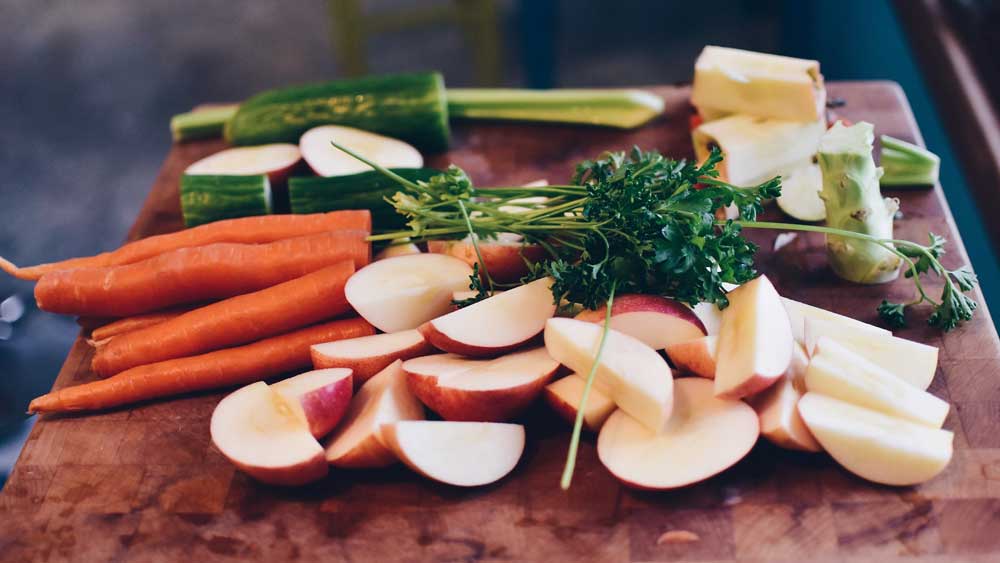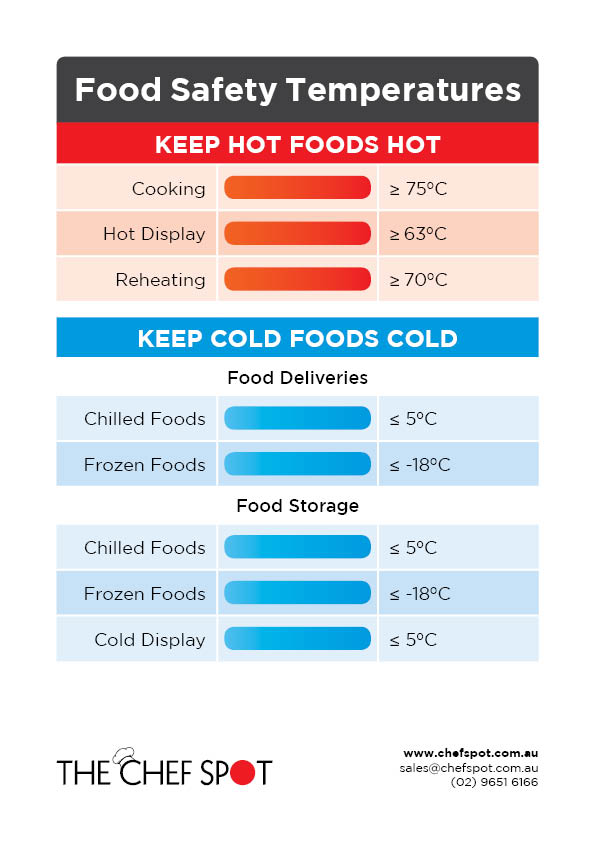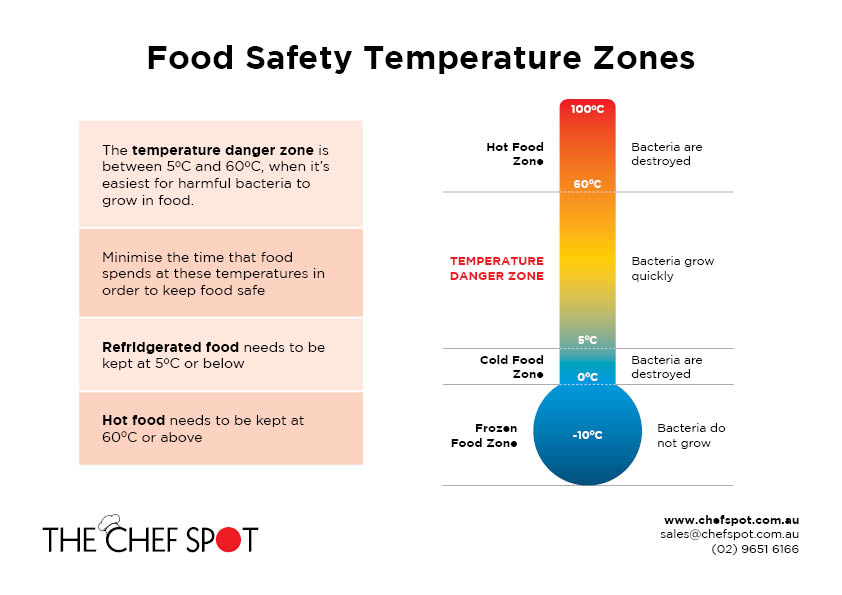Safe Food Temperatures

Safe storing, preparing, and serving of foods is just as important in child care programs as serving a balanced diet. Learn about Safe Food Temperatures for your childcare facility today.
Temperature control
The food safety standards specify that potentially hazardous foods must be stored, displayed and transported at safe temperatures and, where possible, prepared at safe temperatures. However, you can also use time, rather than temperature, to keep food safe. This method is explained under ' The 2 hour/4 hour guide' .
Safe temperatures are 5°C or colder, or 60°C or hotter. Potentially hazardous food needs to be kept at these temperatures to prevent food-poisoning bacteria, which may be present in the food, from multiplying to dangerous levels. These bacteria can grow at temperatures between 5°C and 60°C, which is known as the temperature danger zone. The fastest rate of growth is at around 37°C, the temperature of the human body.
The food safety standards also require you to have a thermometer if you prepare, handle or sell potentially hazardous food. This will enable you to check that safe temperatures are being maintained.
What foods are potentially hazardous?
Foods normally considered to be potentially hazardous are:
- raw meats, cooked meats and food containing meat, such as casseroles, curries, lasagne and meat pies
- dairy products and foods containing dairy products, such as milk, cream, custard and dairy-based desserts
- seafood (excluding live seafood) and food containing seafood, such as seafood salad
- processed fruits and vegetables, such as prepared salads and ready-to-eat fruit packs
- cooked rice and pasta
- processed foods containing eggs, beans, nuts or other protein-rich food, such as quiche and soya bean products
- foods that contain any of the above foods, such as sandwiches, rice salads and pasta salads.
Keeping Food Cold
When you are preparing food, make sure that you have enough refrigerator space or insulated boxes with ice bricks to store the food. It is important to remember that refrigerators do not work properly when they are overloaded or when food is packed tightly, because the cold air cannot circulate.
If you are running out of room in your refrigerator, remove foods that are not potentially hazardous, such as drinks. The temperature of these foods is not critical and they can be kept cool in insulated containers with ice or ice blocks.
Cooling foods
If potentially hazardous foods have to be cooled, their temperature should be reduced as quickly as possible. The temperature should fall from 60°C to 21°C in less than two hours and be reduced to 5°C or colder in the next four hours. It is difficult to cool food within these times unless you put food into shallow containers.
Keeping food hot
If you are keeping food hot on cooktops, in ovens or in bain Marie units, the equipment needs to be set high enough to ensure that the food remains hot ( 60 ° C or hotter).
The 2-hour / 4-hour Guide
Although potentially hazardous food should be kept at 5°C or colder or 60°C or hotter wherever possible, this food can be safely between 5°C and 60°C provided it is between these temperatures for less than four hours. This is because it takes more than four hours for food-poisoning bacteria to grow to dangerous levels.
The 2 hour/4 hour guide applies to ready-to-eat potentially hazardous food. It provides guidance on how long this type of food can be held safely at temperatures between 5°C and 60°C and what should happen to it after certain times. The times refer to the life of the food, including preparation and cooling, not just to display times, so remember to add up the total time that the food has been between 5°C and 60°C.
|
Total time limit between 5°C and 60°C |
What you should do |
|
Less than 2 hours |
Refrigerate or use immediately |
|
Between 2 hours and 4 hours |
Use immediately |
|
More than 4 hours |
Throw out |
Why have a thermometer?
A thermometer is essential in ensuring that food is kept at safe temperatures. If your organisation prepares, handles or sells any potentially hazardous food, it must have a thermometer which is accurate to ±1°C. This means that when the thermometer shows a temperature of 5°C, the actual temperature will be between 4°C and 6°C. The thermometer must be available for use when foods are being prepared, so you may need more than one if foods are prepared in different places.
How to clean and sanitise your thermometer
As the probe of the thermometer will be inserted into food, the probe must be cleaned and sanitised before it is used to measure the temperature of the food. This is especially important when the thermometer is used to measure the temperature of raw food and then ready-to-eat food, for example, raw chicken and cooked chicken. To clean and sanitise your thermometer:
- wash the probe to remove any grease and food particles;
- sanitise the probe using alcohol wipes or very hot water; and
- thoroughly dry the probe using a disposable towel or let it air dry.
Checking temperatures of food
- Determine the warmest area of a cool room or the coldest area of a hot display unit.
- Insert the clean, dry probe into the food.
- Remember that temperature readings are not instant- wait until the temperature has stabilised before reading.
- Stabilise the thermometer between measuring hot and cold foods by allowing the thermometer to come back to room temperature.
- If the food is packaged or frozen, place the length of the probe between two packages of the food.
Remember that the temperature at the centre of food may be different from the surface temperature. For example, when cooked food is being cooled in the refrigerator, the centre of the food will take the longest to cool. Therefore, when checking the temperature of this food, make sure that you check the centre.
How to check the accuracy of your thermometer
Thermometers have to be accurate to ensure that temperatures are correctly measured. Ask the company that supplied your thermometer how often the thermometer should be checked for accuracy. It is best to have your thermometer regularly checked and maintained by the supplier of the thermometer. However, if you would like to check the accuracy of your thermometer yourself, use the following method.
- Place some ice into a container with a small amount of cold water. The ice should not float if the correct amount of water is used.
- Mix into a slurry and insert the thermometer probe.
- Leave it for about three minutes.
- Check and note the temperature. It should read 0°C.
- Do this three times and compare the temperatures recorded.
If they vary by more than 1°C, get your thermometer checked by the supplier.


